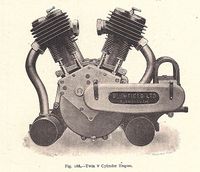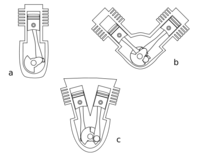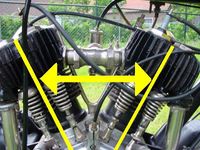V engine
A V engine is a common configuration for an internal combustion engine. The pistons are aligned so that they appear to be in a V when viewed along the line of the crankshaft. The V configuration reduces the overall engine length and weight compared to an equivalent straight engine.
In 1896, Karl Benz patented his design for the first internal combustion engine with horizontally opposed pistons. Usually, each pair of corresponding pistons from each bank of cylinders share one crank pin on the crankshaft, either by master/slave rods or by two ordinary rods side by side. Some authorities even regard this as a distinguishing feature of a true V engine, and for example divide flat engines into boxer engines which do not share crank pins in this way, and 180° engines which do. On the other hand, some important V-twin engine designs have two-pin cranks. However, in German, these engines are all identified as boxermotors.
Various angles of V are used in different engines; depending on the number of cylinders, there may be angles that work better than others for stability. Very narrow angles of V combine some of the advantages of the V engine and the straight engine (primarily in the form of compactness) as well as disadvantages; the concept is an old one pioneered by Lancia, but recently reworked by Volkswagen.
Some V configurations are well-balanced and smooth, while others are less smoothly running than their equivalent straight counterparts. With an optimal angle V16s have even firing and exceptional balance. The crossplane V8 can be balanced with counterweights on the crankshaft similar to those used on a straight 6. V12s, being in effect two Straight 6 engines married together, always have even firing and exceptional balance regardless of angle. Others, such as the V2, V4, V6, flatplane V8, and V10, show increased vibration and generally require balance shafts.
Certain types of V engine have been built as inverted engines, most commonly for aircraft. Advantages include better visibility in a single-engined airplane, and lower centre of gravity. Examples include World War II German engines produced by Daimler-Benz and Jumo.
It is common for V engines to be described with V# notation, where # is how many cylinders it has:
See also
| Piston engine configurations | |
|---|---|
| Straight | Single, 2, 3, 4, 5, 6, 8, 9, 10, 12, 14 |
| V | 2, 4, 5, 6, 8, 10, 12, 16, 20, 24 |
| Flat | 2, 4, 6, 8, 10, 12, 16, H |
| W | 8, 9, 12, 16, 18 |
| Other inline | H, VR, Opposed, U (Square), X |
| Other | Hemi, Radial, Rotary, Pistonless, Deltic, (Wankel) |
| Heat engines | |
|---|---|
| Stroke cycles One • Two • Four • Six • | |
| Engine types Gas turbine • Piston • Jet • Rocket engine • Steam engine • Stirling engine • Tschudi• Twingle Rotary • Wankel • Free-piston • Britalus • Coomber • Swing-piston • Orbital • Quasiturbine | |
| Valves Cylinder head porting • D slide • Four-stroke • Manifold • Multi • Piston • Poppet • Sleeve | |
| Piston layouts Single cylinder • Straight • Opposed • Flat • V • W • H • Deltic • Radial • Rocket engine nozzle • Rotary • Stelzer • Controlled Combustion • Bourke | |
| Motion mechanisms Cam • Connecting rod • Coomber rotary • Crank • Crank substitute • Crankshaft • Linkages (Evans • Peaucellier-Lipkin • Sector straight-line • Watt) • Double acting/differential cylinder | |
| Thermodynamic cycle |


